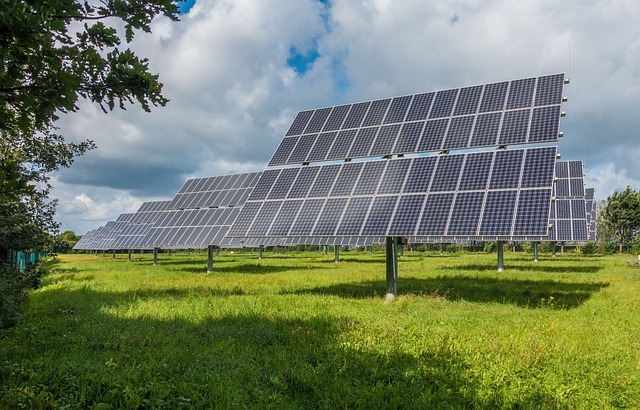Table of Contents
ToggleSolar energy is one of our planet’s most readily available and easily accessible energy sources. Hence, solar panels are increasingly being installed and utilized to lower energy costs.
Photovoltaics (PV), commonly referred to as solar power panels, absorb solar energy and turn it into usable electricity for your home. Thus, renewable power can be created by installing solar panels. Additionally, residential solar panel aids in reducing the harmful greenhouse gas emissions contributing to global warming.
While you’ve most probably seen or heard of solar panels on residential roofs, did you know that ground-mounted panels are one of the most cost-effective ways to generate renewable energy.? This article covers ground-mounted solar panels thoroughly and will assist you in deciding whether to invest in ground or roof-mounted solar panels.
What are ground-mounted solar panels?
Ground-mounted solar panels are solar panels installed anywhere on a property instead of on a home’s roof, where they are typically placed. They are a fantastic alternative if a home’s rooftop cannot support it or is unsuitable for a rooftop solar array.
The installation of solar panels requires a sufficient amount of open space and acceptable sun exposure if the panels are to be mounted on the ground. Residential ground-mount solar panels are commonly built using 60-cell panels, just like home rooftop solar systems. While for solar farms and other large-scale applications, 72-cell solar panels are used.
Types of ground-mounted solar panels
There are two types of structures for residential ground-mounted solar panels – standard-ground mounts and pole-mounted solar systems.
Standard-ground mounts
Standard ground mounts employ ground anchors to hold up a steel frame that is pushed into the ground at various spots to support the solar panels at a set angle. This system is more affordable and simpler to install and maintain than pole-mounted solar systems.
However, with varying altitudes, water tables, and environments, the soil might be sandy, soft, rocky, or clay-rich. So, ground-mount systems require installers to manage several specific soil restrictions. In addition, depending on the underlying soil type, different mounting techniques might be used.
Examples of mounting techniques include I-beams, helical anchors, ground screws, concrete piers, and ballast.
Pole-mounted solar systems
A pole-mounted solar system is fixed to the ground with a single mast, raising the solar panels higher off the ground. A square or rectangular frame is mounted with solar panels at the top of the mast; thus, a single pole supports several panels.


Pros and cons of ground-mounted solar panels
Now, let’s dive into the pros and cons of ground-mounted solar panels to better understand before investing in them.
Advantages of ground-mounted solar panels
Besides producing a renewable energy source and reducing our carbon footprint, ground-mounted solar panels offer many other benefits.
Flexibility
The most significant advantage is that ground-mounted solar panels offer flexibility, as the panels can be installed anywhere, in any direction, and at any height. Therefore, a design that increases the possibility of producing more solar energy can be selected because the panels can be positioned at various heights and angles for optimal sun exposure. First, however, it is crucial to consider how the racking system is set up.
Trouble-free
Ground-mounted solar panels are far more accessible than roof-mounted panels, making them simpler to maintain, clean, and troubleshoot. A ground installation may also be dismantled and moved if homeowners need to use the space for anything else in the future.
Undamaged roof
Another advantage is that owners would not have to worry about lousy wiring starting a solar panel fire on the roof or incorrect installation problems damaging the roof.
Since there is no rooftop construction needed, ground mounts are simpler and safer to install by oneself. In addition, as previously mentioned, the bracings used in typical ground-mount systems are lightweight and easy to remove, with no drilling necessary.
More exposure to the sun
Ground-mounted solar systems have the potential to produce more energy because they are unrestricted by any obstruction, unlike rooftop systems. For example, solar on rooftops have obstructions like chimneys, trees, or neighbouring structures, lengthening the payback time.
More electricity can be produced on the ground as solar panels get the most sun exposure. Therefore, more solar power is generated, which increases consumers’ power bill savings.


Solar carport
Ground-mounted solar panels are also able to support a solar carport. Solar carports help reduce energy bills with easy electric vehicle charging and provide shade for your car. Thus, choosing this option is great if you have an electric vehicle.
Disadvantages of ground-mounted solar panels
On the other hand, there are also drawbacks to ground-mounted solar panels.
Costly
In contrast, the cost of ground-mounted solar panels is higher than that of roof-mounted solar panels in terms of labour as installation requires more work and is time-consuming.
Environmental impact
In rare cases, ground mounts might harm the environment. For example, crop clearance or the removal of overhanging trees may be necessary for large systems to install the panels. Pole mounts may be the solution for these cases as they can reach sufficient heights to avoid obstructing animals or crops.
Home aesthetics
Panels on the ground can interfere with a home’s overall aesthetic more than those installed on the roof, as they take up space on a property. House owners also require a sufficiently clear area to prevent the system from being shaded.
Prone to damage
Ground-mounted solar systems are more susceptible to damage due to their accessibility to wandering wildlife and exposure to dust and debris. Additionally, new buildings or enlarging trees can shade ground installations from the sun.
Permit
Lastly, some homeowner associations may not allow ground mounts in some countries. Therefore, there are many aspects to consider before investing in a ground-mounted solar panel. For example, one must determine if a property has the right conditions, apply, and wait for permit approval.
How do ground-mounted solar panels work?
Ground-mounted solar panels can be manually adjusted a few times annually to accommodate seasonal sun variations.
They can also be equipped with tracking systems, which trace the sun’s ever-changing position in the sky and adjust the solar panel system’s placement. As a result, the panels can absorb the most solar energy possible. Thus, the tracking system aids in maximizing sunlight absorption throughout the day and seasons.
Solar trackers enable ground-mounted systems to rotate vertically, horizontally, or both. Here are two ways to classify them:
Single-axis: Single-axis trackers rotate horizontally from east to west or vertically up and down. These trackers can only carry out one of these tasks, and most of the pick are east-west trackers.
Dual-axis: Dual-axis trackers are more expensive because they are more complicated than single-axis trackers. They can rotate both up and down as well as east to west. By doing this, solar energy is absorbed more effectively and, thus, saves more money.
Depending on the geographic location, dual-axis solar tracking, as compared to a permanent installation, can boost solar panel power generation by up to 40%. On the other hand, single-axis tracking often increases productivity by at least 25%. In addition, pole mounts make it simpler to apply solar trackers.
How far from a house can ground-mounted solar panels work?
Solar panels can be installed up to 500 feet from a house. However, lengthy and expensive wires are required to prevent energy loss. The farther from home, the longer the cable is needed, thus increasing the system’s cost. If a distance of 100 feet or less is maintained, the energy and voltage drop will be 3% or less, which is an acceptable limit for current.
What angle are ground-mounted solar panels usually at?
The best installation angle for ground-mounted solar panels is between 30 and 45 degrees, near or equivalent to the latitude of a south-facing roof.
How much do ground-mounted solar panels cost?
After-tax incentives, private homeowners should anticipate paying anywhere between $17,000 and $34,000. On the other hand, companies or communities can expect to spend between $800,000 and over $1.3 million.
The price of ground-mounted solar panels before and after subsidies varies significantly for residential companies or communities. It depends on the typical monthly energy bill and system size because the after-incentive costs reflect the widely accessible solar investment tax credit and accelerated depreciation (kW).
However, the price of a solar installation varies depending on the solar panels used and the type of installation, equipment, location, and terrain of a property.
Although ground-mounted solar panels are more expensive, they are far more effective and may produce even more electricity if equipped with a solar tracking system. As a result, buyers can repay their investments more quickly.
How many ground-mounted solar panels will you need?
The average home requires about 20 to 25 solar ground-mounted panels. Nevertheless, criteria such as panel efficiency, geographic location, and typical energy usage must be considered to determine the precise quantity of solar panels needed.
How tall are ground-mounted solar panels?
The first row is typically put at the height of 3 feet if the system is installed on level ground. The standard dimension of residential solar panels is 65 by 39 inches (17.6 square feet). However, it all depends on the number of panels required.
Ground-mounted solar panels vs rooftop solar – Which one should you get?
Ground-mounted systems give convenient access for installation and repair, but they also take up a little more room and require a sizable amount of accessible property. However, they are more costly than roof-mounted solar systems. Nevertheless, systems installed on the ground typically outperform rooftop systems. As such, they work well for big properties.
Because routine solar panel cleaning is crucial, having a ground-mounted system makes the procedure easier and eliminates the need for a team. This is due to the easy access of having everything within reach.
On the other hand, rooftop-mounted solar is an excellent option if there is a shortage of space on a property. This is because roof mounts utilize infrastructure that is already available. Furthermore, installing a roof-mounted system frees up valuable property areas that would have been used for solar. Therefore, this system is optimal for smaller properties or homes without extra land space.
Roof-mounted systems are also less expensive than that ground-mounted systems. Buyers will work with an already-built structure, so they are spared the expense of purchasing supplies like poles or concrete and do not need to have their soil assessed before installation.


Read ‘Rooftop Solar Panels: Generating Green Energy For Your Home’ for more on rooftop solar.
Conclusion
All in all, there are many aspects to consider before deciding between ground-mounted or rooftop panels. Roof-mounted solar is the best option if you have limited space and want to save money upfront. However, ground-mounted systems are unquestionably your best option if you have the area and are searching for the most effective solar energy solution.
For more on solar panels and solar energy, head to Justsolar.com.





